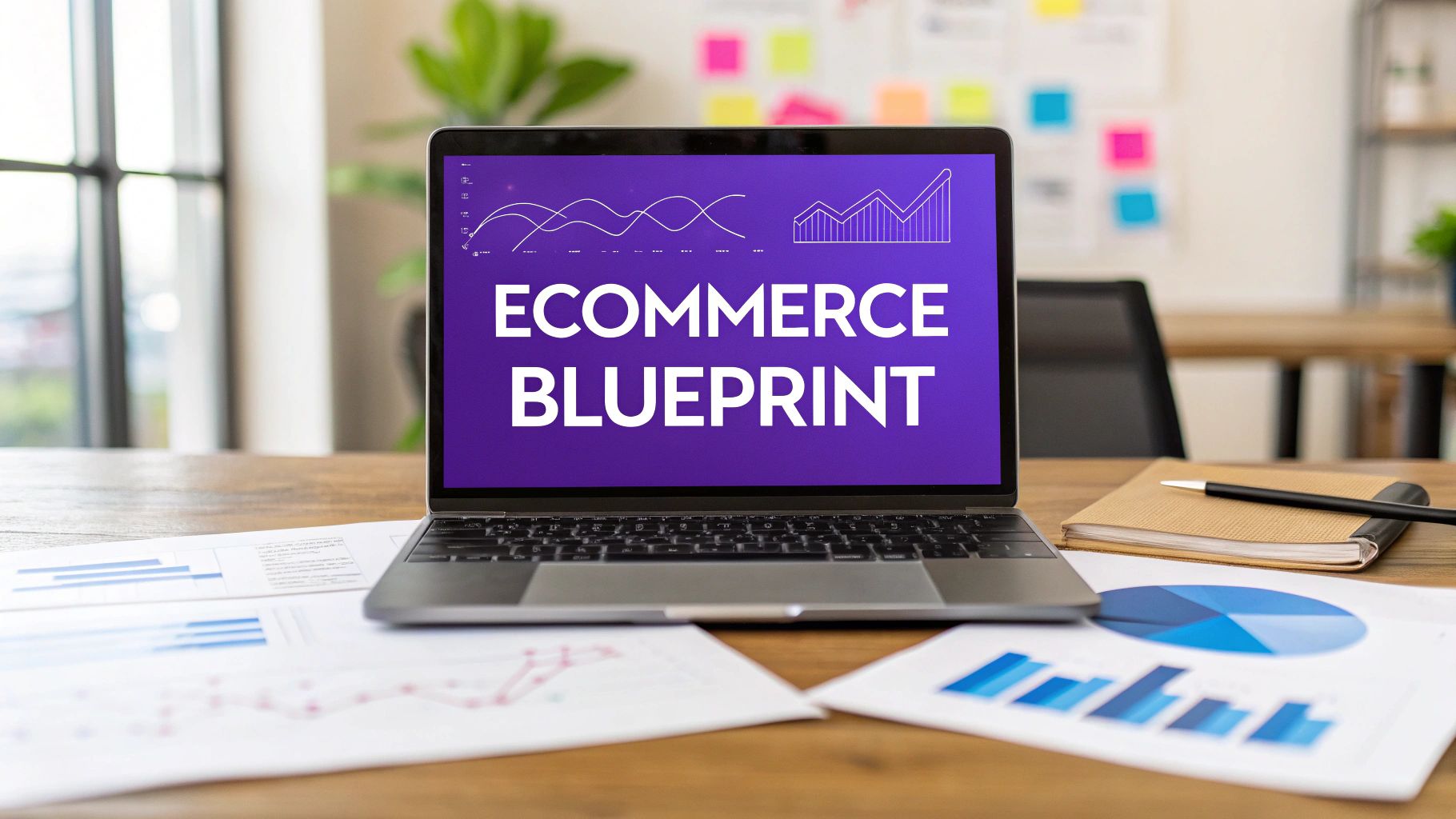Free Ecommerce Business Plan Template: Your Step-by-Step Guide To Online Store Success

Understanding Today's Ecommerce Landscape

Building a successful online store goes beyond just offering great products - you need a solid grasp of how ecommerce works today. A clear business plan template helps guide you through this complex world of online retail. The numbers tell an impressive story: ecommerce now makes up 20.8% of all retail sales as of 2023, and that share is expected to reach 24% in the coming years. In dollar terms, we're talking about a $6.31 trillion global market that's on track to exceed $8 trillion by 2026. While these figures show there's plenty of opportunity, they also point to some fierce competition in the online space.
Identifying Profitable Niches
Finding your sweet spot in this bustling marketplace means zeroing in on specific customer needs rather than trying to be everything to everyone. For instance, rather than running a generic home decor shop, you might focus on eco-friendly handmade items for minimalist homes. This targeted approach helps you market more effectively and build a dedicated following. Think about what makes your store special - maybe it's outstanding customer service, personalized product suggestions, or a genuine commitment to sustainability. Having this clear identity helps you connect with the right customers and stand out from the crowd.
Analyzing Market Conditions and Competition
Of course, finding your niche is just the start. Your business plan needs to include careful research into market trends and what your competitors are doing. Take a jewelry store specializing in handmade pieces - they'd want to know which materials are trending, how competitors price their items, and where they advertise. This kind of market insight shapes everything from your pricing strategy to product development and marketing plans. Your business plan should be flexible enough to adapt as market conditions change.
Positioning Your Store for Sustainable Growth
Building a lasting ecommerce business requires more than just getting new customers through the door - you need to keep them coming back. This might involve setting up rewards programs, creating interesting content, and making sure customers feel supported after they buy. Just like the early online retailers of the 1990s needed solid business plans to succeed, today's ecommerce entrepreneurs need a clear roadmap to thrive in an even more complex market. A well-thought-out plan helps you stay focused on your goals, prepare for challenges, and build a business that lasts.
Building Your Product and Operations Strategy

When starting an ecommerce business, having a clear product and operations strategy is essential for long-term success. This strategy guides every step from finding suppliers to delighting customers. Let's explore the key elements that make up a strong product and operations foundation.
Evaluating and Selecting Suppliers
Your choice of suppliers directly impacts your ability to deliver quality products on time. While cost matters, it shouldn't be the only factor. For instance, if you're selling organic cotton t-shirts, you'll need to verify suppliers' organic certifications and labor practices to maintain your brand's integrity. Look carefully at their production capacity and lead times too - running out of inventory means disappointed customers. Take time to thoroughly evaluate potential suppliers based on quality, reliability, communication, and values alignment.
Mastering Inventory Management
Managing inventory requires careful balance. Keep too little stock and you'll miss sales opportunities. Order too much and you'll tie up cash while risking items becoming obsolete. Think of it like managing a restaurant's ingredients - you need enough to serve customers without waste. Start with a simple spreadsheet or basic inventory software to track stock levels, predict demand patterns, and automate reordering. This helps optimize inventory while controlling costs. Small adjustments in your approach can have big impacts on both the bottom line and customer satisfaction.
Creating a Seamless Fulfillment Process
Getting products safely to customers is crucial for retention and growth. Consider the disappointment of receiving a damaged book weeks after ordering - that's a broken fulfillment process. You'll need to choose between handling fulfillment in-house, dropshipping, or working with a third-party logistics provider (3PL). Each option has different costs, levels of control, and ability to scale. Document your chosen method along with detailed procedures for processing orders, shipping products, and handling returns.
Prioritizing Quality Control and Customer Service
Strong quality control and excellent service build customer trust and encourage repeat business. No one wants to receive a flawed handmade item - it instantly damages your reputation. Put quality checks in place at key points from sourcing through packaging. Train your team to provide quick, helpful responses to questions and handle issues with care. A good CRM system helps track customer interactions and personalize service. Remember that keeping current customers happy often costs less than finding new ones. Make quality and service central to your strategy, not afterthoughts.
Crafting Your Marketing Engine
A great product alone won't lead to ecommerce success. You need an effective marketing strategy to attract visitors, build recognition, and turn browsers into buyers. This requires carefully combining SEO, content marketing, and paid advertising into a cohesive plan. Just as early online retailers in the 1990s needed solid business strategies to succeed, having a clear ecommerce business plan is key for guiding your marketing efforts today.
Understanding the Power of SEO
SEO forms the foundation for getting found online organically. When you optimize your store to rank well in search results for relevant terms like "ecommerce business plan," you make it easier for potential customers to discover you. Think of search engines as librarians organizing vast amounts of information. Your job is to help them properly categorize your "book" (website) so people can find it. For example, if you sell handmade jewelry, using specific keywords like "sterling silver earrings" in product descriptions helps shoppers looking for those exact items locate your store.
Content Marketing: Building a Community
Quality content works hand-in-hand with SEO by providing real value to your target audience. This could include blog posts with jewelry styling advice, behind-the-scenes videos showing your craftsmanship, or guides about caring for different gemstones. Similar to how physical stores build community through workshops and events, content marketing helps you connect with customers online. When you consistently share helpful information, you establish trust and encourage loyalty among your audience.
Paid Advertising: Amplifying Your Reach
While SEO and content create lasting organic growth, paid ads let you quickly expand your visibility to new audiences. Through platforms like Google Ads and social media advertising, you can precisely target people based on demographics and interests. Say you're launching eco-friendly clothing - paid ads help you reach consumers already interested in sustainable fashion. Like traditional retailers placing ads in specific magazines, digital advertising enables even more targeted outreach.
Measuring and Optimizing Your Efforts
Just as machines need maintenance, marketing strategies require ongoing monitoring and refinement. Track key metrics like customer acquisition cost (CAC) and customer lifetime value (CLV) to gauge what's working. For instance, high acquisition costs but low lifetime value may signal problems with your targeting or pricing. By regularly analyzing performance data and adjusting your ecommerce business plan accordingly, you can optimize your marketing investments for better returns. This data-driven approach helps build a reliable system for attracting customers and growing sales over time.
Making Numbers Work For Your Store

Success in ecommerce relies on more than just great products and smart marketing - it needs a strong financial foundation. When you understand your numbers and use them to guide your decisions, you can build a profitable and sustainable business. That's why creating a detailed financial section in your business plan is so important. Think of it as your financial roadmap that helps you stay on track and grow smartly.
Projecting Your Ecommerce Finances
Financial projections are like creating a map before starting a journey - they help guide the way forward. While you can't predict everything perfectly, making educated estimates about your sales, costs, and profits gives you clear targets to work toward. For instance, if you run a handmade jewelry business, you might plan to sell 100 pieces monthly at $50 each, aiming for $5,000 in monthly revenue. But revenue is just one piece of the puzzle - you need to weigh this against your actual costs.
Understanding Your Ecommerce Costs
Getting a handle on your costs is essential for running a profitable store. Every expense matters - from the obvious ones like materials and manufacturing to operating costs like website hosting, marketing campaigns, and shipping fees. Don't overlook smaller expenses either - things like transaction fees and packaging supplies can add up fast. Going back to our jewelry example, if each piece costs $20 to make and you spend $1,000 monthly on operations, your total costs would be $3,000. This leaves you with $2,000 in potential profit, giving you a clear picture of your business's financial health.
Pricing Strategies for Ecommerce Success
Smart pricing is key to keeping customers happy while making enough profit to sustain your business. You've got several pricing approaches to consider. Cost-plus pricing involves adding a set markup to your production costs. Value-based pricing looks at what customers are willing to pay based on how much they value your products - this works especially well for unique or handcrafted items. You might also want to check out what competitors charge and position your prices accordingly, particularly in crowded markets.
Managing Ecommerce Cash Flow
Think of cash flow as your business's pulse - it shows how money moves in and out of your operations. When more cash comes in than goes out, you can invest in growth, handle regular expenses, and prepare for unexpected challenges. But if cash flow goes negative, it can quickly create problems. Good cash flow management means carefully tracking income and expenses, keeping inventory levels balanced, and setting clear payment terms with suppliers and customers. You can manage this with a simple spreadsheet or dedicated accounting software. Just as early online stores had to carefully watch their resources in the 1990s, smart cash management remains vital for today's ecommerce businesses of all sizes. By staying on top of your cash flow, you'll have the resources needed to grow and succeed in online retail.
Choosing Your Technology Foundation

The success of your online store depends heavily on having the right technology working together seamlessly. Much like a well-oiled machine, each component needs to function properly on its own while also integrating smoothly with the other parts. Looking back at pioneers like Amazon and Dell shows us that having solid technical infrastructure was key to their early success - and it's even more important today.
Ecommerce Platforms: The Heart of Your Online Store
Think of your ecommerce platform as the engine that powers your entire online store. It needs to be reliable and match your specific business needs. Popular options like Shopify, WooCommerce, and BigCommerce each have their own strengths. For example, Shopify excels at being user-friendly and offers tons of apps to extend functionality. WooCommerce works great if you're already using WordPress and want more control. Take time to evaluate which platform aligns best with your goals and budget before making this crucial decision.
Payment Gateways: Ensuring Smooth Transactions
Nobody likes a clunky checkout process. It's like going to a store only to find out they don't accept your preferred payment method - frustrating, right? That's why offering multiple payment options is essential. Modern customers expect to pay using credit cards, PayPal, Apple Pay, and other digital wallets. Look for payment gateways that work well with your chosen platform, have fair fees, and prioritize security. The smoother the payment process, the happier your customers will be.
Inventory Management Systems: Staying Organized and Efficient
Think about inventory management like keeping a well-organized kitchen - you need to know exactly what you have, what you need, and when to restock. A good system shows you real-time stock levels, helps predict future needs, and automates reordering when supplies run low. When this system connects directly to your online store, it prevents overselling and keeps everything running smoothly. This organization is key to maintaining customer satisfaction and managing costs effectively.
Other Essential Tech Considerations for Your Ecommerce Business Plan Template
Beyond these core systems, several other tools play vital supporting roles. Email marketing helps you stay connected with customers and build loyalty. Analytics tools show you what's working and what isn't in your marketing efforts. CRM systems help you provide better customer service by keeping track of all customer interactions. For instance, when your CRM talks to your email marketing system, you can send personalized offers based on what customers have bought before.
Security needs special attention too. Online stores face increasing threats from cybercriminals, making protection of customer data absolutely essential. Include plans for SSL certificates, two-factor authentication, and regular security checks. Being proactive about security builds trust with customers and protects your business from potential problems. When putting together your business plan, make sure to address how you'll handle all these technical pieces - it shows you understand what it takes to run a successful online store.
Protecting Your Digital Business
Every successful online store needs a solid business plan, but many store owners overlook a critical component - protecting their business from risks. Just like physical stores need security systems and insurance, online businesses must guard against fraud, cyber threats, and supply chain problems that can hurt profits and damage customer trust.
Understanding the Risks in Ecommerce
Running an online store comes with unique security challenges. Fraudulent credit card transactions cost merchants billions each year. Data breaches and hacking attempts can expose sensitive customer information and disrupt sales. Supply chain issues, from shipping delays to inventory shortages, can leave you unable to fulfill orders. These problems don't just impact your bottom line - they can permanently damage your reputation with customers.
Implementing Security Measures
Good security starts with basic protections, like requiring strong passwords and two-factor authentication for all accounts. Think of it like locking your doors at night - a simple but essential safety measure. Install quality antivirus software and firewalls to block malicious attacks. Keep all your website software and plugins updated with the latest security patches. Each layer of protection helps keep hackers out and customer data safe.
Managing Supply Chain Risks
Don't rely on just one supplier for critical products or materials. For instance, if you sell handmade jewelry, having multiple sources for gems and metals means production won't grind to a halt if one supplier has issues. Build strong partnerships with your vendors through regular communication. Keep extra inventory of essential items on hand as a buffer against shipping delays. This advance planning helps ensure you can keep filling orders even during supply disruptions.
Developing a Crisis Management Plan
Despite your best efforts, problems can still arise - whether it's a data breach, natural disaster, or PR crisis. Having a clear crisis response plan helps you act quickly to minimize damage. Designate who will handle communications, outline steps for different scenarios, and prepare key messages in advance. Like a fire drill prepares you for emergencies, crisis planning ensures you can respond effectively when issues occur.
Ready to build a thriving and secure online store? Wand Websites provides the expert design, strategic guidance, and technical support you need to succeed in the competitive world of ecommerce. We handle the technical complexities so you can focus on what you do best - creating amazing products and connecting with your customers. Visit Wand Websites today to learn more and start building your dream online store.


